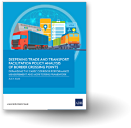The pandemic’s economic impact will be deep, but proactive policies will help
To mitigate the damage, governments should focus on containing the pandemic, helping families and supporting businesses
The COVID-19 pandemic continues to weigh heavily on health and economic systems around the world. Millions have been infected and hundreds of thousands have lost their lives. Border controls continue to be strictly implemented in many countries, impairing global production capacity, and creating one of the most serious crises in history.
The ongoing pandemic as a “crisis like no other,” according to the June World Economic Outlook Update of the International Monetary Fund, which has downgraded its global growth forecast to -4.9% for 2020. The World Bank, in its Global Economic Prospects, in June cut its forecast to -5.2% and called the crisis one of the deepest recessions in over 150 years, next to recessions after World War I, in the 1930s, and after World War II. ADB also cut its growth projection for Developing Asia by over 2%—since April— to 0.1% in 2020, the lowest regional growth outcome in six decades.
A recent ADB report estimates the COVID-19 economic impact will range from $5.8 trillion if the outbreak is contained and economic conditions normalize in 3 months, to $8.8 trillion if it takes longer or 6 months to rein in the virus and normalize economic conditions As a share of global GDP, the damage could range from 6.4% to 9.7%, excluding the impact of government measures taken to mitigate its impact. About 30% of this global impact will be accounted for by Asia, where in the two scenarios output will fall by $1.7 trillion and $2.5 trillion, which is 6.2% to 9.3% of regional GDP.
The pandemic will also likely reverse some of the hard-won development gains that Asia has achieved since the global financial crisis.
The ADB study also notes severe employment effects from the pandemic. Globally, 158 million to 242 million jobs will be lost in the two scenarios (6.0% and 9.2% of total employment). For Asia, the drop in employment will reach 109 million to 167 million jobs—or as much as 69% of total employment losses globally. This estimated impact is more than seven times the employment decline in Asia during the 2008–2009 global financial crisis—which reduced employment by about 22 million people, measured on a fulltime job equivalent basis.
Moreover, the pandemic will also likely reverse some of the hard-won development gains that Asia has achieved since the global financial crisis. For example, relative to a scenario without COVID-19, the long containment scenario—where it takes 6 months to contain the virus and normalize economic conditions—will see 56 million people move into extreme poverty, earning $1.90 a day or less, and 140 million surviving on $3.20 a day.
For these reasons, strong government support of households and businesses is warranted. This could take the form of payroll support, subsidies, unemployment assistance and help for job-seekers. Cash transfers to those in the informal employment sector, and the distribution of essential services and commodities, including through community feeding programs, are also vital. Incorporating this type of government policy response could soften COVID-19’s economic impact by as much as 30%–40%, reducing global economic losses to $4.1 trillion–$5.4 trillion (4.5%–5.9% of global GDP), the ADB study noted.
Policymakers should continue to focus on three key actions at this time. First, governments must do all they can to contain the pandemic as soon as possible to reduce the economic costs. Sufficient testing, tracing and isolation, effective social distancing, and securing protective and medical equipment are critical elements.
Second, it is important for governments to help struggling families and businesses mitigate adverse impacts of the pandemic and to head off the long-term consequences for growth and development that could otherwise occur. Third, governments need to manage supply chain disruptions, support e-commerce and technology solutions for delivering goods and services, and prepare for a gradual opening of economies when things get better. And they will get better.
Original article was published at the ADB Blog and duplicated here with permission from the author. *




